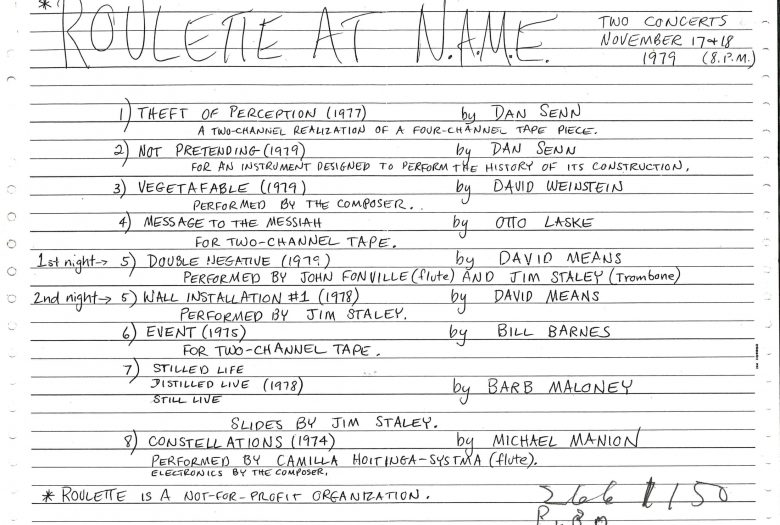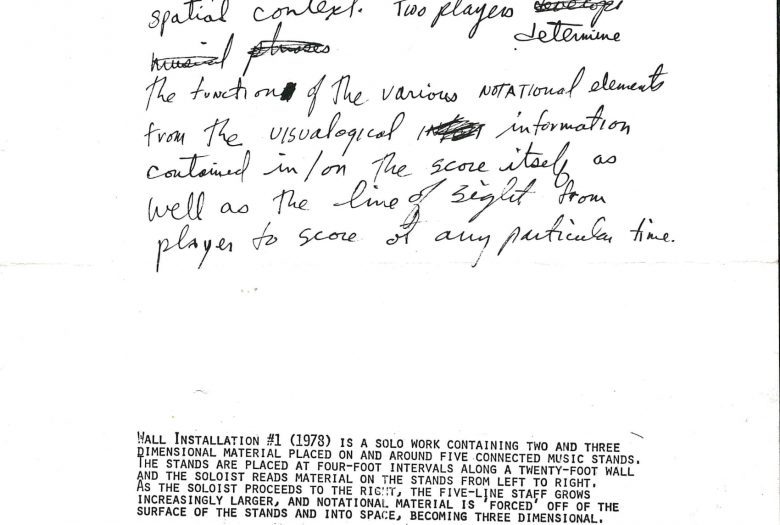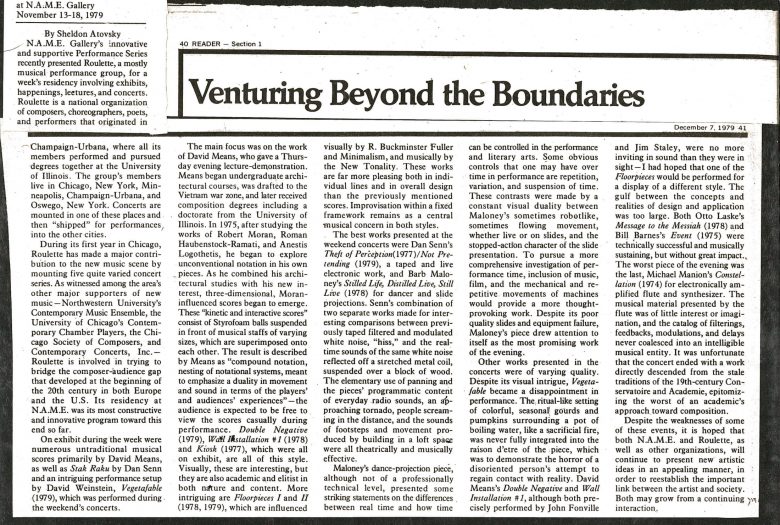by Sheldon Atovsky
originally published in The Chicago Reader, December 7, 1979
November 13–18, 1979
N.A.M.E. Gallery’s innovative and supportive Performance Series recently presented Roulette, a mostly musical performance group, for a week’s residency involving exhibits, happenings, lectures, and concerts. Roulette is a national organization of composers, choreographers, poets, and performers that originated in Champaign-Urbana, where all its members performed and pursued degrees together at the University of Illinois. The group’s members live in Chicago, New York, Minneapolis, Champaign-Urbana, and Oswego, New York. Concerts are mounted in one of these places and then “shipped” for performances into the other cities.
During its first year in Chicago, Roulette has made a major contribution to the new music scene by mounting five quite varied concert series. As witnessed among the area’s other major supporters of new music—Notherwestern University’s Contemporary Music Ensemble, the University of Chicago’s Contemporary Music Ensemble, the University of Chicago’s Contemporary Chamber Players, the Chicago Society of Composers, and Contemporary Concerts, Inc.—Roulette is involved in trying to bridge the composer-audience gap that developed at the beginning of the 20th century in both Europe and the U.S. Its residency at N.A.M.E. was its most constructive and innovative program toward this end so far.
On exhibit during the week are numerous untraditional musical scores primarily by David Means, as well as Stak Raku by Dan Senn and an intriguing performance setup by David Weinstein, Vegetafable (1979), which was performed during the weekend’s concerts.
The main focus was on the work of David Means, who gave a Thursday evening lecture-demonstration. Means began undergraduate architectural courses, was drafted to the Vietnam war zone, and later received composition degrees including doctorate from the University of Illinois. In 1975, after studying the works of Robert Moran, Roman Haubenstock-Ramati, and Anestis Logothetis, he began to explore unconventional notation in his own pieces. As he combined his architectural studies with his new interest, three-dimensional, Moran-influenced scores began to emerge. These “kinetic and interactive scores” consist of Styrofoam balls suspended in front of musical staffs of varying sizes, which are superimposed onto each other. The result is described by Means as “compound notation, nesting of notational systems, meant to emphasize a duality in movement and sound in terms of the players’ and audiences’ experiences”—the audience is expected to be free to view the scores casually during performance. Double Negative (1979), Wall Installation #1 (1978), and Kiosk (1977), which were all on exhibit, are all of this style. Visually, these are interesting, but they are also academic and elitist in both nature and content. More intriguing are Floorpieces I and II (1978, 1979), which are influenced visually by R. Buckminster Fuller and Minimalism, and musically by New Tonality. These works are far more pleasing both in individual lines and in overall design than the previously mentioned scores. Improvisation within a fixed framework remains as a central musical concern in both styles.
The best works presented at the weekend concerts were Dan Senn’s Theft of Perception (1977)/Not Pretending (1979), a taped and live-electronic work, and Barb Maloney’s Stilled Life, Distilled Live, Still Live (1978) for dancer and slide projections. Senn’s combination of two separate works made for interesting comparisons between previously taped filtered and modulated white noise, “hiss,” and the real-time sounds of the same white noise reflected off a stretched metal coil, suspended over a block of wood. The elementary use of panning and the pieces’ programmatic content of everyday radio sounds, and approaching tornado, people screaming in the distance, and the sounds of footsteps and movement produced by building in a loft space were all theatrically and musically effective.
Maloney’s dance-projection piece, although not of a professionally technical level, presented some striking statements on the differences between real time and how time can be controlled in the performance and literary arts. Some obvious controls that one may have over time in performance are repetition, variation, and suspension of time. These contrast were made by a constant visual duality between Maloney’s sometimes robotlike, sometimes flowing movement, whether live or on slides, and the stopped-action character of the slide presentation. To pursue a more comprehensive investigation of music, film, and the mechanical and repetitive movements of machines would provide a more thought-provoking work. Despite its poor quality slides and equipment failure, Maloney’s piece drew attention to itself as the most promising work of the evening.
Other works presented in the concerts were of varying quality. Despite its visual intrigue, Vegetafable became a disappointment in performance. The ritual-like setting of colorful, seasonal gourds and pumpkins surrounding a pot of boiling water, like a sacrificial fire, was never



